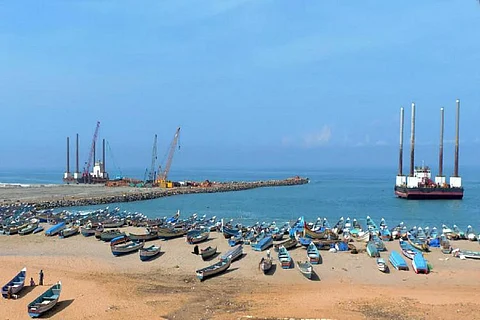

Coastal erosion at Shangumugham and Valiyathura in Kerala’s Thiruvananthapuram was not because of the construction of the sea port at Vizhinjam as was claimed by the fisherfolk, but due to stormy weather patterns in the last few years, a draft White Paper placed before an expert committee appointed by the National Green Tribunal has said. The White Paper, jointly drafted by the National Institute of Ocean Technology (NIOT), the National Centre for Earth Science Studies (NCESS) and L&T Infrastructure Engineering Ltd, was placed before the committee last week, said Prasad Kurien, general manager-environment at Vizhinjam International Seaport Ltd (VISL).
According to studies carried out by the three agencies, an unprecedented increase in the number of storms during the fair-weather period (October to April) in recent years resulted in high waves leading to erosion. Besides the stormy weather, the presence of a groyne field at Beemapally, located around a couple of km to the south of the Valiyathura coast, was another reason for the beach or coastline not rebuilding naturally, according to the White Paper.
"A plausible reason for the erosion at Valiyathura and its northern coastal stretches is the presence of the groyne field to its south (Poonthura to Beemapally). After Ockhi cyclone in November 2017, Valiyathura and Shangumugham coasts are subjected to high-wave activity due to increase in number of storm events and cyclones, as a result of which, the earlier (prior to Ockhi) normal process of beach rebuilding during the fair-weather period (October to April) has not been happening," it said.
According to Dr Jayakumar, CEO of Vizhinjam International Seaport Ltd, during the monsoon season the area witnesses soil erosion along the coast and the following fair-weather period, when seas are comparatively calm, there are deposits of sediment on the beach, rebuilding it.
This natural cycle was not taking place in the last few years, especially after Ockhi, Jayakumar told PTI.
However, Joseph Vijayan, who had moved the NGT against the environment clearance given to the sea port project and as a result of which the expert committee was appointed, does not agree with the White Paper.
He termed the draft report as "illogical, unscientific and skewed" and claimed that it was aimed at protecting the project and the concessionaire.
In support of his claim, Vijayan said the report does not properly clarify why the stormy weather only affected the areas north of the port and why there was soil accretion on the southern parts during the same time.
He said the coastline much further along to the north also remained unaffected by the adverse weather phenomenon of the past few years and this has also not been addressed in the report.
"The climate is being made a scapegoat. Areas which were made vulnerable due to human interference or intervention were the ones which were adversely affected by the adverse weather," he told PTI.
At the same time, he conceded there was poor sediment movement last year which was why there were not major changes to the Kerala coastline after the 2022 monsoon season.
"That situation might change next year," he added.
On being asked about his views regarding the recently-called off protest against the sea port, Vijayan said it was a genuine cause and that he sympathised with the protestors.
Priests of the Latin Church Archdiocese, leading the protestors, could not be reached for comments regarding the White Paper.
The White Paper said, "The erosion at Shangumugham and Valliyathura cannot be attributed to the construction of the upcoming port at Vizhinjam as per the studies. The shoreline analyses show that the trend of erosion at the erosion hotspots viz. Valiyathura, Shangumugham and Poonthura are the same before and after the commencement of the port."
It further stated that according to studies, the extent of impact due to any intervention on a straight coastline would be only within 8 to 10 times the length of protrusion.
"Vizhinjam port is located within a concave coast, which deviates beyond a certain length, coupled with rocky promontories and pocket beaches. The breakwater of the port protrudes only about a km into the sea. Therefore, the coastal erosion at Valiyathura and Shangumugham beaches, which are 13 km and 15 km away from the breakwater, cannot be attributed to the construction of the upcoming port," it said.
It said with sediment bypassing, the erosion at Valiyathura and Shangumugham is expected to reduce and the beach is likely to become stable in a few years with adoption of appropriate site-specific shore protection measures.
Kurien said the expert committee suggested that the White Paper be simplified, so that local residents and those opposed to the project can better understand it, and the final report be placed before it within two weeks.
On December 6 last year, the over 130-day-long protest by fisherfolk against the under-construction Vizhinjam sea port was called off after discussions between those who led the agitation and Kerala Chief Minister Pinarayi Vijayan.
They had been pressing for a 7-point charter of demands that included stopping the construction work and to conduct a coastal impact study in connection with the multi-crore project.
The agitators had been alleging that the unscientific construction of groynes, the artificial sea walls as part of the upcoming port, was one of the reasons for the increasing coastal erosion.